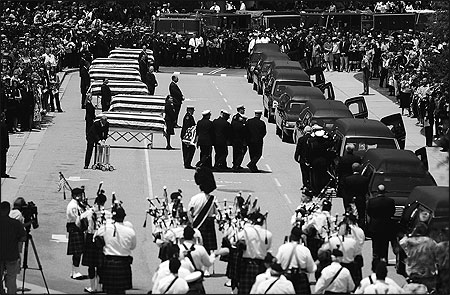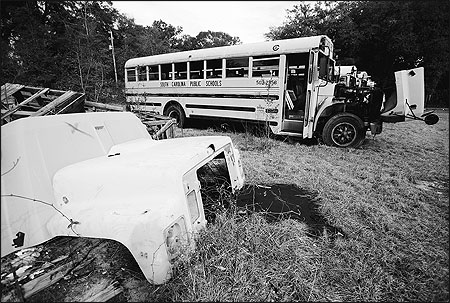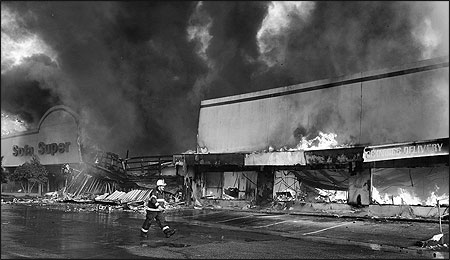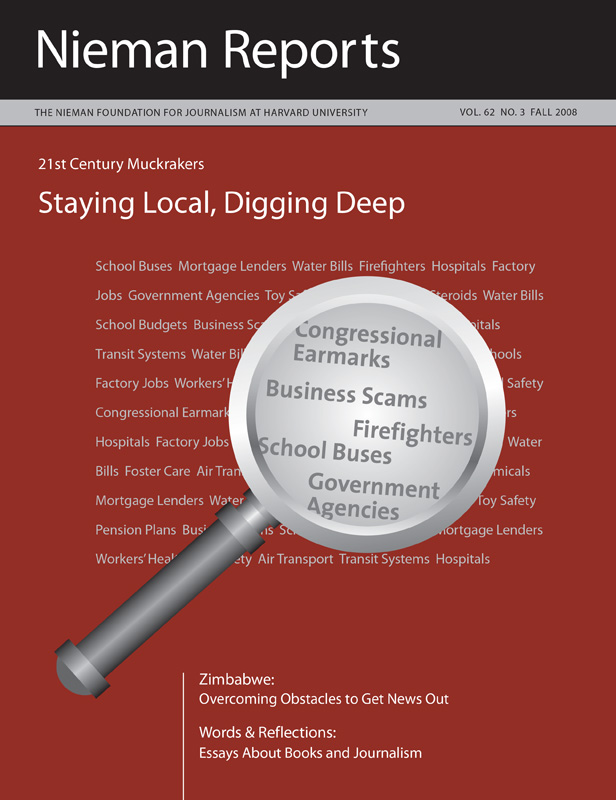
I sat in the darkened auditorium, my face illuminated by the glow from my laptop screen. It was June 18th, the one-year anniversary of the Sofa Super Store blaze that killed nine Charleston, South Carolina firefighters in 2007. I was blogging for my newspaper, The Post and Courier, from a memorial service marking the solemn occasion. As slide-show images of the fallen firefighters flashed on a giant video screen, I reflected on the past year—the tragedy that rocked our city and our newspaper’s efforts to investigate what went wrong.
In the wake of the blaze, we uncovered numerous failings in the Charleston Fire Department that directly contributed to these firefighters’ deaths. Our stories prompted a complete overhaul of the fire department, the abrupt retirement of a beloved fire chief, and pledges from the mayor to rebuild the department into a national model.
But a sense of guilt gnawed at me that day. If we’d been a public watchdog before the fire, perhaps this loss of life might not have happened. Of course, it’s hard to say if we could have pulled off an investigation back then given the revered status of our fire chief and the mayor’s constant refrain about our city having the country’s best fire department, with firefighters known for their daring rescues and selfless heroics. No firefighter had been lost in the line of duty in decades. Why should the local newspaper be questioning the department’s practices and expounding on what might happen?
Yet that’s exactly what we should have done.
Why do I feel so certain about this? Not long before this tragic fire, our newsroom faced a similar question about whether to investigate the dismal condition of South Carolina’s 6,000 public school buses. No one had died, nor had anyone been seriously injured on a state-owned school bus. So who were we to question the condition of the aging fleet of buses or the safety of those who ride in them?
But if there were problems—and we had reason to think there were after a series of bus fires around the state the previous year—then the lives of the tens of thousands of children who rode them each day were in danger. So we decided that their safety and the potential for disaster were too great to ignore. In our three-part series published in March 2007, “School Bus Breakdown,” the evidence we’d gathered enabled us to reveal that our public school buses were the oldest, most polluting, and least safe in the nation.
To tell this story, another reporter, Mindy Hagen, and I spent months crisscrossing the state interviewing parents, teachers, bus drivers, bus mechanics, and others to find out whether—and then describe specifically how—the state’s school buses were putting children’s safety in jeopardy. By employing the state’s open records laws, we obtained school bus maintenance and accident records. We compiled the information into a database and used that to document an alarming trend of accidents, including the fact that all too often buses were suddenly catching fire with children onboard.

Newsroom Demands
Reporting and writing the bus series differed dramatically from how we would end up tackling the investigation we did after the fire. For starters, on the school bus series, I was teamed with Hagen, a young beat reporter who, while talented and energetic, had never worked an investigation. During our work on that story, she continued to be responsible for covering two large county school districts. (The newsroom—in the midst of belt-tightening and a hiring freeze—could find no other reporter to take over that coverage.) Throughout the assignment, her beat responsibilities often took priority over the school bus project, and I was left nudging it toward the finish line on my own.
As a general assignment reporter at the time, I was also forced to set aside my reporting on this project as harried city desk editors requested my help with the daily paper. I tried not to complain too much because I knew that times were tough on everyone in our newsroom given the financial constraints we now faced. When even one of us was freed up to focus on the school bus project, I felt fortunate that some progress was being made.
But this on-and-off approach sapped our momentum and motivation. The important work of building and exploring a complicated database became next to impossible. Only after we’d wrapped up our reporting and prepared to write the series was Hagen given a block of time to help me craft the three main stories and sidebars.
Once completed, our series revealed how children in public schools were often forced to ride buses with more than 400,000 miles—buses that lacked modern safety features such as antilock brakes and extra emergency exits. Our investigation determined that the state agency in charge of school bus maintenance was undercounting the number of bus fires, and we quoted by name bus experts and school officials who predicted that it was only a matter of time before one of these decades-old buses claimed the life of a child.
Our series prompted a public outcry. State lawmakers reacted by immediately passing a law requiring the state to retire and replace a portion of school buses every year. In many ways, this series was a classic newspaper investigation—the findings growing slowly over time, then hitting the front page with a big splash.
After completing this series about the buses in the old-fashioned way—pleading for more time and balancing project demands with other reporting duties—the investigation of the fire department followed a very different track. Reporting on it was more methodical, with a newsroom strategy of publish-as-you-go being applied to what was found. The fire was simply too big of a story to not throw everything at it. So we worked the story just about full time, almost like a regular beat, for months.

Investigating a Tragedy
The Post and Courier newsroom did not have a formal investigations team when the fire broke out on the evening of June 18, 2007. It was the country’s worst firefighting tragedy since 9/11. A small outdoor trash fire swept into the sprawling furniture store and boiled into a raging inferno, killing nine firefighters when they became disoriented in the coal-black smoke and maze of flammable couches.
The fatal blaze devastated our city not only because of the scope and suddenness of the loss but because of the hype we’d heard for so long from the mayor and fire chief about our fire department. Frequently, they touted the department’s top national rating from the insurance industry. But what we soon learned was that this rating had almost nothing to do with the department’s actual capabilities and that the “Best in America” motto was a myth.
Once we started our examination of the department it became apparent that the tragedy had been decades in the making. The fire department’s tactics, equipment and training were 30 years behind the times, and it was completely unprepared to handle a fire of such magnitude.
From the start, our executive editor, Bill Hawkins, had made it clear that the fire was one of the bigger stories in our city’s history. We would not cede any ground in reporting on it. In the first few days after the fire, story assignments were a free-for-all. No idea seemed too far-fetched or unjustified. Any reporter who wanted to pitch in could.
Our early coverage broke news by describing how the city discouraged businesses from installing fire sprinklers by charging exorbitant fees, how lax code enforcement failed to flag illegal building additions at the sofa store, and how the department’s practices at the fire conflicted with contemporary firefighting standards and guidelines.
Over time, the number of reporters working the story tapered off. It was then that I found myself paired with veteran police reporter Glenn Smith, with whom I’d been teamed on another investigation about bad cops a couple of years earlier. In working on that story, we’d developed an effective collaboration, and as we started our work on this project we knew that our comprehensive examination of this fire needed to answer the core question: How could this happen?
RELATED ARTICLE
"Needed: A Leader to Champion the Cause"
— Doug PardueOur projects editor, Doug Pardue, argued that the fire story’s significance (by then, it had generated a lot of national interest) and the circumstances unfolding around us meant that a traditional multipart series wasn’t the best direction in which to head. Firefighters and fire service professionals from around the country were calling and e-mailing us to point out things in photos and video of the fire that looked totally wrong. They were mystified by the sight of firefighters running around the blaze without proper safety equipment. But most were reluctant to go on the record while the fire department and city were still reeling. When the fire chief issued a gag order on his firefighters, our access to the local fire stations evaporated overnight.
As we began our investigation—by assembling and verifying what we’d heard from these fire experts—the number of alleged inconsistencies and mistakes at the fire seemed overwhelming. In part, we felt this way because at that point we lacked understanding about the firefighting profession. So we backed away and spent countless hours educating ourselves. We attended firefighting conferences, read fire journals, and talked with lots of firefighting experts, whether they were in our backyard or thousands of miles away.
We organized the myriad problems we’d been told about into categories with titles such as safety, incident command and water supply, and began to investigate each one, then publish what we learned. With each successive story, new tips surfaced. What we came to realize is that the accuracy of our reporting on technical subjects gained us credibility within the fire service, and this encouraged reluctant sources to share what they knew with us. Had we waited to publish a lengthy series, at least some of what we were able to include in our reporting would very likely have been missing.
In the newsroom, there was never much doubt that the investment of time and resources were worthwhile. The death toll was so high—even by firefighting standards—it was evident something had gone terribly wrong. Our editors, from the top down, trusted that we’d eventually piece it together.

Lessons Learned
Working on these two assignments taught me much about investigative reporting. In neither case did I work on my own. Having a colleague to share the workload is critical, since a collaborative effort offers an intangible that is often overlooked as team members act as a cheerleader for one another and for the project. Another lesson: the need for a dedicated projects editor to orchestrate. Pardue shepherded both projects from day one, keeping us focused and inspired. He even helped report and write a couple of the fire stories.
These projects demonstrated that investigative reporting can be just as effective at revealing why something did happen as it can be in documenting how something could happen. And both of these projects received numerous state and national reporting awards. All of this helped persuade our top editors that even with this work being a resource-heavy load to carry in our slimmed down newsroom, investigative reporting is worthy of special focus and the reporting time it takes to get it right.
Recently, The Post and Courier set up a dedicated investigations desk called Watchdog. As we work to get our new team off the ground, we are trying to keep in mind that not all good investigative stories need to spring out of tragedy. Instead, watchdog journalism can help prevent the tragedy from occurring in the first place. What our fire reporting showed us was echoed in what post-tragedy reporting uncovered in the Minnesota bridge collapse last year: perilous conditions were there to be discovered before people died. The loss of life in both of these tragedies might have been averted if journalists here and there had devoted more time to questioning policies and practices at governmental agencies responsible for public safety and infrastructure.
It’s certainly possible—though not able to be proven—that our investigative reporting has helped head off the deaths or injury of children riding the state’s school buses. That we’ll never really know is a credit to investigative journalism.
Ron Menchaca, an investigative reporter at The Post and Courier, was named 2007 Journalist of the Year by the South Carolina Press Association. The probe of the fire received the 2008 National Headliner Award for investigative reporting and a 2007 Sigma Delta Chi Award for nondeadline reporting.
